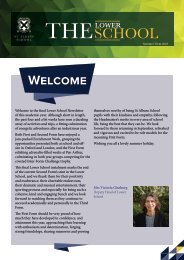Create successful ePaper yourself
Turn your PDF publications into a flip-book with our unique Google optimized e-Paper software.
Political Ideologies<br />
15<br />
How was Nazi ideology<br />
reflected in their architecture?<br />
A<br />
fter coming to power in 1933,<br />
Adolf Hitler and his Nazi Party<br />
began a radical transformation of<br />
German culture, including architecture.<br />
Indeed, architecture played a large role in<br />
Hitler’s regime, with his chief architect Albert<br />
Speer becoming one of the most important<br />
men in the Nazi government by<br />
the 1940s. <strong>The</strong> designs formulated<br />
by the Nazis very<br />
much reflected their political<br />
agenda.<br />
Firstly, Nazi architecture<br />
reflected the authoritarian<br />
and populist nature of<br />
their rule and their ideology.<br />
Hitler himself was renowned<br />
for his populist<br />
tactics, including large<br />
public addresses which<br />
sought to enthuse his followers<br />
and whip up support.<br />
As a result, his architecture<br />
often accommodated<br />
such methods of outreach. For example,<br />
a 30 square kilometre area near<br />
Nuremburg was supposed to be developed<br />
in order to host up to 500,000 guests<br />
for Nazi rallies, demonstrating how the<br />
populist elements of Nazi ideology were<br />
mirrored in their architecture. Likewise,<br />
plans for a new city called ‘Germania’ to<br />
replace Berlin included buildings such as<br />
the ‘Volkshalle’, or People’s Hall, further<br />
demonstrating the populist nature of Nazi<br />
ideology, and echoing their desire to build<br />
a utopian society with similarly named<br />
policies such as the ‘Volksgemeinschaft’.<br />
Nazi architecture also reflected the more<br />
sinister, authoritarian elements of their regime.<br />
Indeed, many of the planned buildings<br />
were designed in such a way that<br />
they highlighted the domineering nature<br />
of their rule. <strong>The</strong> aforementioned<br />
Volkshalle was planned to have a 300-metre-high<br />
dome in the style of Hitler’s favoured<br />
neo-classicism. Hitler even stated<br />
that ‘our enemies and followers must realise<br />
that these buildings strengthen our authority’,<br />
perhaps because the sheer size of<br />
his buildings would have dwarfed the individual<br />
and acted as a visible metaphor<br />
for extreme state power.<br />
Likewise, architecture was used by the<br />
Nazis as a means by which to demonstrate<br />
their supposed supremacy over rivals and<br />
those who they viewed as ‘inferior’. Supremacy<br />
played a large role Nazi propaganda<br />
– they sought to build the image of<br />
the supposedly superior Aryan race. <strong>The</strong>y<br />
truly believed that the Aryans were a<br />
‘master race’ who prevailed over all others,<br />
especially over the perceived ‘inferior<br />
races’ such as the Slavs and the Jews. Indeed,<br />
there is much evidence of their bid<br />
for Germanic superiority in their architecture.<br />
Firstly, only German materials were<br />
used in many of their most important architectural<br />
projects.<br />
<strong>The</strong> proposed<br />
‘Volkshalle’ of Berlin


















